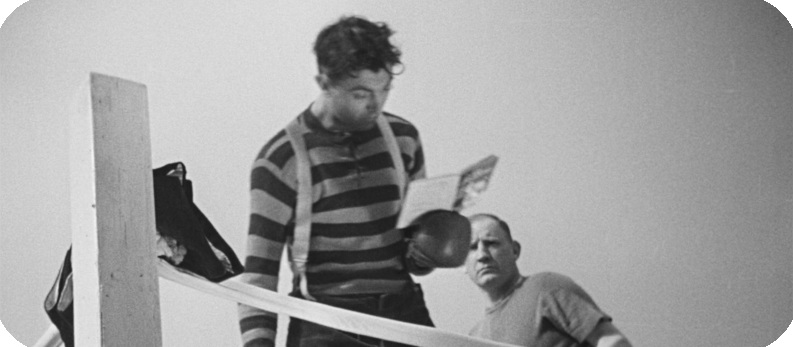This post tackles the most important of The Good, the Bad and the Ugly’s ongoing problems, the inferiority of the easily-available “Extended Cut” to the more evasive “International Cut” — only the latter of which was prepared and approved by Leone himself.
Read MoreThe Good, the Bad and the Ugly: Comparing Audio Presentations on Home Video
This first post compares the representations of the The Good, the Bad and the Ugly’s original mono audio track in the Laserdisc releases of the early 90s and the Blu-ray releases of the mid-2010s.
Read MoreNotes on Tati: Soigne ton gauche
It’s common consensus that Soigne ton gauche is the best of the three 30s shorts to star Jacques Tati, a consensus with which I’m inclined to agree. And while it gives strong indications that Tati was growing as a writer and a screen performer, an equally critical factor in its success is René Clément, one of his only comedies and earliest efforts as director here but a competent and accomplished work nonetheless. Clément favours a rapid, highly dynamic pace through highly varied and dynamic camera angles, energetic camera movements, occasional undercranking, and rapid edits. This last point — at once the most accomplished stylistic trait of the film and perhaps its most misguided — makes itself clear as soon as the short opens.
Read MoreOn the unknown self in "Asako I & II" (2018)
In romance stories every happy ending is the same, and every tragic finale is different. If there is a space between, it’s maddeningly difficult to define in anything but contradictory terms: if love does not end happily, how can it avoid some trace of tragedy? But how many of our own personal stories of romances cannot be cleanly sifted into one box or another, but are instead held in our memory in a slow, wobbling uncertainty, for months or years or decades before we can finally pack them away and assume they’ll never come open again? And who doesn’t on some level fear the re-emergence of some past romantic episode?
Read MoreNotes on Tati: Gai dimanche (1935)
While On demande une brute is by any standard a thoroughly clumsy work that neither conforms clearly to Tati’s pre-filmic mime act nor the tastes and interests he would come to display as the world’s pre-eminent master of cinematic high comedy, Gai dimanche is both an unmistakably formative work and a far greater success. The setup foregrounds the modus operandi that came to define Tati’s approach: breakdowns of human behaviour across class that show up the absurdity of social programming and how it pervades spaces of work and of leisure.
Read MoreShot Analysis: The Matrix (1998)
My favourite shot in The Matrix doesn’t have quite the same glitzy showiness as so many of the movie’s other high points, and I hope I can be forgiven for declaring a self-consciously arty and moody moment as the visual peak of a film that raised the bar for accessible pop moviemaking with its photographic bombast. But my favourite it is, and I’d like to deconstruct it to explain why.
Read MoreA Monument to Death: The mad melancholy of Ed Wood's "Bride of the Monster" (1955)
This is the first and most expensive film in Wood's legendary Kelton Trilogy, and in many ways it shows: sets frequently resemble the locations they aim to represent, camera movements are fairly regular occurrences, and the lighting is more elaborate and attractive than anything seen in Plan 9 from Outer Space or Night of the Ghouls. What's more, while the film's construction is shabby by any typical Hollywood standard of craft, this provides more genuine technical showmanship than any other Wood movie I've seen, with ambitious and well-motivated movements, expressive blocking, and a daring willingness to slow the pace down — and yes, it’s on purpose.
Read MoreNotes on Tati: On demande un brute (1934)
As the oldest surviving film to feature Jacques Tati, this provides an interesting ground zero for his talents, even if it's a pretty lousy cast-off of a comedy. Here, Tati co-wrote with Alfred Sauvy this short about a young, lanky actor named Roustabat, who has trouble getting cast, and whose domestic partner is constantly insulting him and his vocation. Meanwhile, a low-level fight organizer is having trouble booking an opponent for a wrestling match he's already sold out (nobody wants to fight his infamously brutish star fighter), and so he publishes in the newspaper a vague call for men "specializing in violent roles". You can probably fill in most of the blanks from there.
Read MoreNotes on John Wick: Chapter 3 (2019)
The particular brand of pop cinema that Stahelski and his team pull off here is something that you can’t find anywhere else, and in a way that makes John Wick: Chapter 3 – Parabellum one of the best modern action movies of its kind. That it is still a decidedly flawed movie may speak to the lack of great work being done in that sphere by Hollywood filmmakers, but it also shouldn’t deter appreciation by what it gets right.
Read MoreNotes on John Wick: Chapter 2 (2017)
For Stahelski, the new comic point of reference isn’t quite a Looney Tunes cartoon, but Buster Keaton. One of the film’s opening shots focuses on a scene from Sherlock Jr. projected on the side of a Manhattan building. The in-your-face delivery of that influence to the audience reflects a very welcome post-modern playfulness with Chapter 2’s own identity. That identity, for what it’s worth, never successfully resolves, but Chapter 2 imperfectly points a potential path for an action movie whose split personality is half the fun.
Read More







